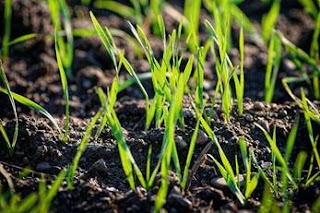Today’s Erosion and Sediment Control Tip: #10
Establishing perennial vegetation by seeding is by far the
most economical way to get permanent vegetative cover on a site. But it
not only has to be done right (seedbed preparation, lime, fertilizer, etc.) but
the seed must have a good chance to germinate and grow prior to its dormant
period. The species of seed selected for a project has its own
recommended seeding dates. The closer you get to the ending date, the
more potential for the vegetation to not survive its period of non-vegetative
growth. For warm-season perennial vegetation (Bermudagrass, Bahia,
etc.) the non-vegetative growth period is the cold winter months, while
the non-vegetative growth period for the cool season perennial vegetation (Tall
Fescue) is the hot summer months. The vegetation needs to germinate (energy
from the seed), and have plenty of time to grow and photosynthesize to provide
the energy for the roots. The stored energy in the roots is what allows
the plant to vigorously grow when the next growing season resumes. If you
can, always plant your grass seed near the beginning of the recommended seeding
dates.




Comments